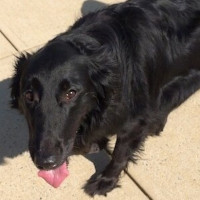 |
Labollie |
|
He is not recognized by the F.C.I. |
Origin |
Canada <> Great Britain -> U.S.A. | |
Translation |
Francis Vandersteen |
A brief presentation of the Labollie |
| The Labollie is a hybrid breed. Its parents are the Collie Rough and the Labrador Retriever. Like its parents, the Labollie is a very family-oriented dog. It also requires very little maintenance to stay at its best. He's very sociable and has a temperament that's ready to please. It is highly trainable, much like its two parent breeds. The Labollie is an excellent companion, whether you're at home relaxing or out walking together. |
History of the Labollie |
| Although there isn't much information on the Labollie, we can study the parent breeds to understand the origins of the hybrid breed. |
A little of the Labrador Retriever |
||
| The Labrador Retriever originated in Newfoundland, Canada. It was originally known as the St. John's dog. Since the 1700s, the Labrador Retriever has been a companion, hunter and retriever for its humans. It is thought that the original St. John's dog was crossed with local water dogs and the Newfoundland dog to create the Labrador we know today. He was brought to England, where he served as a Retriever. After almost disappearing due to tax laws and government restrictions, the breed became very popular after the Second World War. Today, the Labrador Retriever is one of the most popular breeds in America. | ||
 |
||
| Standard of the Labrador Retriever | ||
A little of the Collie Rough |
||
| The Collie Rough is also known for its working ability. It originated in the Highlands of Scotland, where it was used for guarding and breeding. In fact, the breed has guarded all types of animals: cattle, sheep and pigs, to name but a few. Some believe the dog was brought to the British Isles by the Romans. Queen Victoria visited Scotland in 1860 and brought Collies back with her to England. The first Longhaired Collie was brought to the United States in 1879. | ||
 |
||
| Standard of the Collie Rough |
Appearance of the Labollie |
| The Labollie is likely to take on the longer hair of the long-haired Collie parent breed. It will have a double coat like both its parents. The Labollie's color varies, depending on the dominant parent breed. It can be black with white markings, brown or sable. Its dark eyes are alert and friendly, and its nose is black. They are medium-sized dogs, weighing no more than 23 kilos, but with a strong, agile gait. |
Temperament of the Labollie |
| The Labollie is a gentle, affectionate and highly intelligent dog. He's easy to train and will watch his owner for commands. He wants to please his owner, which will minimize behavior problems. However, owners should remember that Labollies are like their parent breeds, they will chew and eat anything and can be prone to digging holes all over the yard. Prevent this by allowing vigorous daily exercise. This hybrid is excellent with children and is renowned for being very patient and gentle. |
Needs and activities of the Labollie |
| Anyone thinking of buying a Labollie should bear in mind that it will be a very athletic dog. He has great stamina and courage. Surprisingly, he's not as active as the parent breeds, so while he may follow you on a jog, he doesn't need hours of play. He loves games, like playing with a Frisbee or just an ordinary tennis ball. He can also enjoy a trip to the dog park. |
Maintenance of the Labollie |
| The Labollie can take on the longer coats of the parent Collie Rough breed, but it's not as high-maintenance as you might think. It has a waterproof undercoat and a coarse topcoat. He is considered a moderate excretor. Expect him to shed heavily twice a year in spring and autumn. Brush it once a week to make sure there's no matting. At least twice a month, trim his nails if they're not wearing down naturally. If you hear his nails clicking on the floor, it's time to trim them. Brush his teeth two or three times a week to prevent tooth decay. |







 English (United Kingdom)
English (United Kingdom)